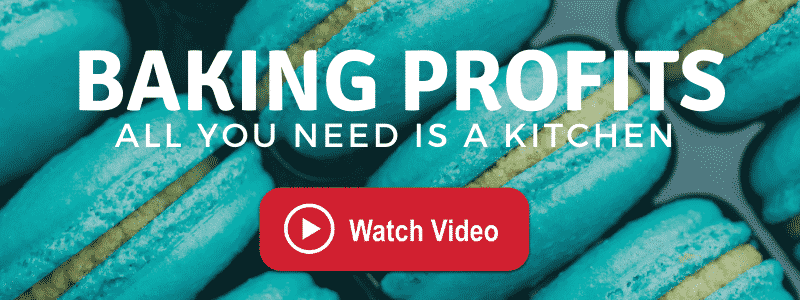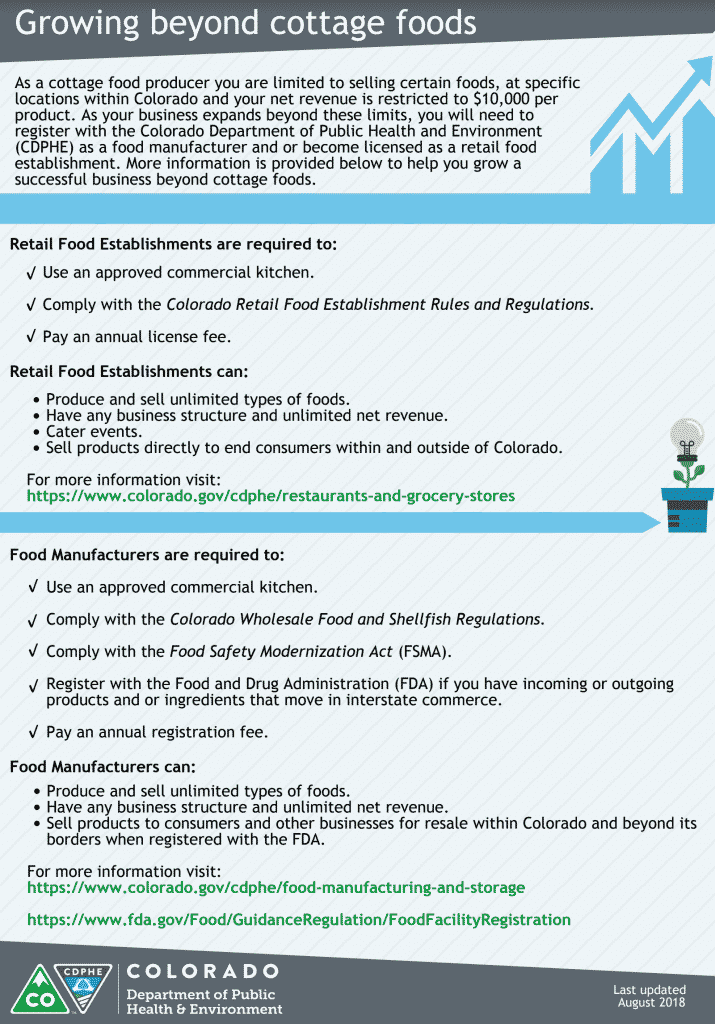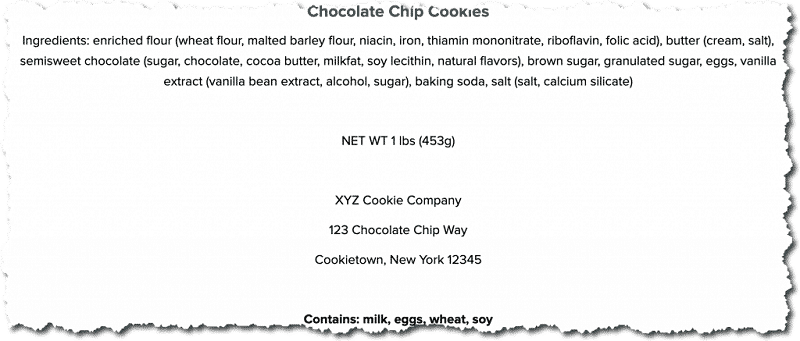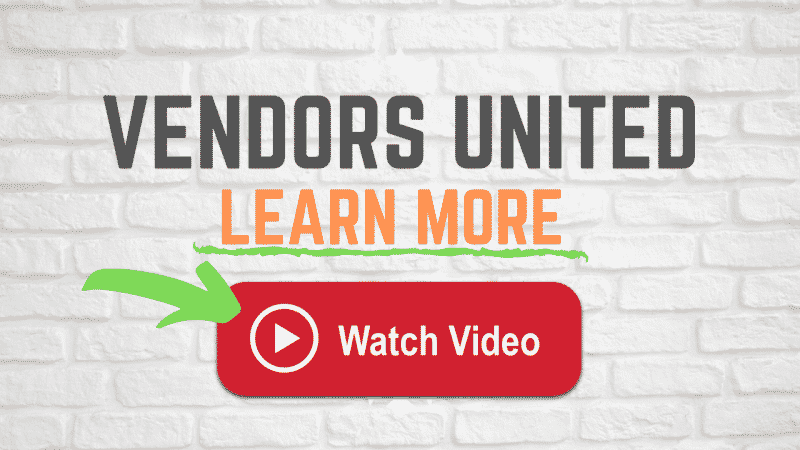New York cottage food laws make it easy to get started. They allow direct sales, online sales and market sales in person.
Getting started is as simple as saying… I’m going to open and run my own cottage food operation from my home – starting right this minute.
Table of Contents
HOW TO START YOUR COTTAGE FOOD BUSINESS IN NEW YORK – LICENSING

STEPS TO START
Always contact your local city / county office and verify if a business license is required prior to starting.
This is simply done by calling the main number to your city and letting them know you are starting a cottage food business and ask if you need a business license.
- Pick foods to offer from the “allowed” food types listed below.
- Check with your local city/county for any zoning restrictions or business license requirements
- Register with NY Department of Agriculture (FREE) – Email form (contact info below)
- Get labels made (see label example below)
- Start baking/cooking, marketing and selling
Note: If your water supply is from a well, you will likely be required to have the water tested.
Questions? Call: (518) 457-4492
NEW YORK COTTAGE FOOD LAWS – Foods That Are Allowed
The following are some of products allowed to be made from your home. Keep in mind that some items, for example… breads like focaccia bread are not allowed.
Always check first: (see contact info below) VERIFY ANY FOOD YOU PLAN TO MAKE… (518) 457-4492
- Breads
- Breads containing fruits are not allowed
- Rolls and/or cinnamon rolls
- Biscuits
- Bagels
- Muffins
- Doughnuts
- Cookies
- Baklava
- Biscotti
- No chocolate or candy melts allowed for topping
- Cakes
- Cake pops
- No chocolate or candy melts allowed for topping
- Cupcakes
- Brownies
- Double-crust fruit pies
- Scones
- Fruit jams, jellies, and marmalades made with high acid/low pH fruits
- i.e. Apple, apricot, blackberry, blueberry, cherry, clementine, cranberry, currents, elderberry, grape, grapefruit, lemon, lime, nectarine, orange, peach, pear, pineapple, plum, raspberry and strawberry
- Repacking/blending of commercially dried spices or herbs
- Repackaging dried or dehydrated vegetables.
- Repackaging dried soup mixes
- Repackaging dried fruit
- Repackaging of dried pasta
- The manufacturing and drying of pasta is prohibited
- Repackaging dry baking mixes
- Seasoning salt
- Fudge
- Popcorn/caramel corn
- Peanut brittle
- Rice Krispies treats
- Granola and trail mix (using commercially roasted nuts)
- Granola Bars (using commercially roasted nuts)
- Repacking candy (excluding chocolate)
- Melting and/or repacking of exposed chocolates or chocolate-like candies is not allowed
- Waffle cones and Pizzelle
- Toffee/caramel apples
- Candy melts are not allowed
- Confections
- Includes toffees, caramels, hard candies
- Vegetable chips
- Includes potato chips
- Crackers
- Pretzels
- Tortillas
Any finished food product that requires refrigeration is not allowed to be produced as a Home Processor.
Pet foods and pet treats can be made from the home, but require a separate registration.
For more information related to manufacturing and distributing of pet foods, please contact [email protected].
Real Life Cottage Food Entrepreneurs and Opportunities
- Cakes – teacher turns kitchen into bakery
- Doughnuts – cottage mini donut vendor
- Fruit jams and jellies – See Additional Requirements Here
- Kettle corn – real kettle corn vendors from home
- Popcorn (plain and flavored) – see a real home vendor here
- Talk and Join hundreds of others here: VendorsUnited.com
NEW YORK COTTAGE FOOD LAWS – PROHIBITED FOODS
- Potentially hazardous foods
- Most refrigerated foods
- Pickles
- Salsa
- Relish
More examples of Potentially Hazardous Foods:
- Meat (beef, pork, lamb)
- Poultry (chicken, turkey, duck)
- Fish – Shellfish and crustaceans
- Eggs
- Milk and dairy products
- Cooked, plant-based foods (e.g., cooked rice, beans, or vegetables)
- Baked potatoes
- Cut fruit
- Cut vegetables and leafy greens
- Mushrooms
- Raw sprouts
- Tofu and soy-protein foods
- Garlic/herb and oil mixtures
NOTE: Although eggs, milk and dairy products are not allowed, used as ingredients for the allowed foods – is acceptable.
Many prohibited foods that are baked or cooked into the allowed foods are rendered harmless (non-TCS) and therefore allowed.
NEW yORK ANNUAL SALES LIMITS
New York doesn’t have a cap on your annual sales. This is great news and allows you to build up, save up and expand as you want.
Below is what the state of Colorado puts out to help folks wanting to go beyond cottage foods.
Colorado created a brochure on going beyond cottage food once you’ve outgrown or hit your maximum allowed income.
I have provided it here for a resource as you grow your business and wish to expand.

ACIDITY LEVELS AND TESTING
Most states determine if a food is non-potentially hazardous by the acidity level found in the food. The higher the acidity, the more stable at a range of temps, that food product is.
For example: milk is low acidity and requires temperature controls.
The acidity of foods is measured by pH.
• The range of pH is commonly considered to extend from zero to 14. A pH value of 7 is neutral because pure water has a pH value of exactly 7. Values less than 7 are considered acidic, while those greater than 7 are considered basic or alkaline.
• All fruits are acidic foods and are usually tart and sour. Ex: tomato, lemon, peach, apple, etc.
• The FDA rule for acidic foods states that a food must have a pH below 4.6 to be sold as a minimally processed food.
• The reason for this is bacteria does not grow at this level of acidity.
• The exclusion shall not be construed as allowing the sale of low acid foods (pH > 4.6) in
hermetically sealed containers (i.e. home-canned green beans, peas, etc.) when such
food is not prepared in a permitted establishment.
TESTING
Some states require testing if the pH level is unknown. For many food products, the pH level is already known.
You can test for pH yourself using a pH spear tester. (make sure it is made for food and has a long spear tip).
Oklahoma State University shares an awesome guide for selecting the correct tester for foods and liquids which includes tips and tricks for operation and maintenance. Get The Guide Here.
NEW YORK COTTAGE FOOD LAWS LABELING REQUIREMENTS
The basic information that must be on the label is as follows:
You are required to label your individually packaged products with the following information:
- Name and Address of the cottage food operation
- Name of the homestead food product
- The ingredients of the cottage food product, in descending order by weight
- The name of each major food allergen contained in the food unless it is already part of the common or usual name of the respective ingredient already disclosed in the ingredient statement (see major food allergen list below)
COTTAGE FOOD LABEL EXAMPLE
Below is an example of what New York requires on their labels.
Using VistaPrint.com or similar – you can quickly create professional labels that not only serve to meet the state cottage food guidelines but also serve for marketing your awesome business and products.
You’ll find some fantastic examples of this from members inside VendorsUnited.com

ALLERGENS ON LABELING
The FDA lists nine (9) major food allergens. Listing any of these on your label is a smart business practice and will certainly help your customers choose a product.
- Milk
- Eggs
- Fish (e.g., bass, flounder, cod)
- Crustacean shellfish (e.g., crab, lobster, shrimp)
- Tree nuts (e.g., almonds, walnuts, pecans)
- Peanuts
- Wheat
- Soybeans
- Sesame seeds
Simply add to your label: “CONTAINS: SOYBEANS” Some go as far to announce that a certain allergen is used in the same kitchen.
Some states require you list any potential allergens and potential for any cross contamination even if the allergen is not used in the recipe.
FDA Allergen Labeling Example: Contains Wheat, Milk, Egg, and Soy
WHERE CAN I SELL MY COTTAGE FOOD PRODUCTS
New York Cottage Food Laws – Sales Rules
All sales are restricted to:
- from your own residence
- from your own farm stand
- at a farmer’s market
- online
- mail order in state
- wholesale to New York restaurants, cafes, grocery stores, etc.
Inside kitchenincome.com you can find out how many cottage food entrepreneurs are getting sales faster than they can make the food.
FOOD HANDLER TRAINING AND BEST PRACTICES
New York does NOT require you take a food safety course. However, knowing the safe handling practices will protect you and your customers, it is always a good idea to take a quick online class and get certified.
There are many short courses you can take online and actually get certified and be able to share that with your customers.
Many of our VendorsUnited.com members are proud to display their food safety certificates as a way to insure their customers that they care. This helps your business.
- Short courses that provide food handling and safety certification
- Free info from the FDA – food safety
SAFE PRACTICES
Much of this may seem like common sense, but even if you already know, it’s a good idea to remind yourself with a list of things that can prevent you from missing something small. And if for no other reason… CYA! CYA = Cover Your A#%
CLEAN WORK AREA / WORK SPACE / SANITIZATION
Providing safe to eat foods from your kitchen – starts in your kitchen.
Keep your area clean and sanitized to avoid cross contamination and to insure you provide your customers and clients with the safest and best foods they can get.
The following are some “common” sense things you can do to insure the best environment for preparing foods to sell:
- Keep all equipment and surface areas clean and sanitized
- Make sure window and door screens are bug proof with no gaps
- Keep ingredients separate to prevent cross contamination / e.g. raw eggs near flour
- No pets in work area and preferably none in the home
- Allow no-one with a cold, sniffles or sick in kitchen while preparing foods
- Wipe down walls and clean floors daily
- Use good lighting to avoid missing unclean areas
- Keep window and door screens in good repair to keep insects out
- Wash hands frequently while working and use food grade gloves for extra safety
- Keep areas of food storage and equipment storage clean and sanitized
RECORD KEEPING
Why keep these types of records?
Let’s say the inspector calls you and says they got a report that your banana bread, someone purchased, made them sick.
You’ll be able to show that you didn’t even make banana bread that week and that the person who reported you, bought that 4 weeks ago and you weren’t even the one that sold it to him.
This does not need to be complicated. I love my yellow legal pads and they make an inexpensive tool for keeping up with the following:
- The recipes you use including ingredients
- The process you use to prepare that specific recipe: (can be just like recipe instructions)
- Date made (can be coded for your own use only if your state doesn’t require the production date) e.g. Made 12.22.29 = 292212
- Date sold (you can have a batch code to help track a certain batch) Simply write down date you sold an item
- Location sold is another great piece of information to keep track of
- Sales receipts are something great to keep for a couple of reasons and over at KitchenIncome.com I dive into the best practices, best systems and best methods for tracking, managing, selling and shipping.
COTTAGE FOOD lIABILITY INSURANCE
We live in a society that likes to sue. I can sue you for wearing that color shirt. No kidding! Of course I probably won’t win, but at the very least, it’s gonna cause you stress and some costs.
Liability insurance is a MUST.
It can be expensive – but several years ago, I found FLIP and by far, they gave me the most protection (coverage) and allow you to run your cottage food business without fear of being sued.
WHY? Because they provide the lawyers. And their lawyers… they are good!
Of course you should price shop around with your local agent or a national brand company, but rest assured, I’ve done all the legwork for you.
Alternatively, some folks opt to get bonded. You’ve heard the saying before: “licensed and bonded”. A bond is usually provided from an insurance bonding company or your own insurance company.
My first time, I got a bond at State Farm.
A bond is expensive comparatively but is less out of pocket in the beginning. Of course, it’s way, way less insurance / coverage too.
A $10,000 bond may cost $50 annually while a $2,000,000.00 liability policy may cost a few hundred a year.
No matter what you decide… knowing you’re insured against frivolous lawsuits is worth every penny.
NEW YORK COTTAGE FOOD LAWS IMPORTANT LINKS
- NY State Cottage Food (home processing rules)
- NY State Cottage Food Laws
- NY State Cottage Food Registration
NEW YORK COTTAGE FOOD CONTACT INFO
New York State Department of Agriculture and Markets
Food Safety and Inspection
10B Airline Drive
Albany, New York 12235
[email protected]
(518) 457-4492
UPDATES TO NEW YORK COTTAGE FOOD LAWS
From time to time, links, info, rules and numbers change, are updated or made obsolete.
Although I spend time daily with hundreds of vendors (many of which are cottage food businesses) – I can miss an update.
If you find a broken link or outdated state information… please let me know and I’ll send you a special thank you for helping me maintain the best site on the internet for the cottage food industry.
My goal has always been to have a central place that is absolutely free for those starting out or existing entrepreneurs who use their homes and kitchens to make real incomes.
Please send to [email protected] / or post inside the private VendorsUnited.com group.
Need more resources? Check it out HERE (Helpful Resources)
Take a peek at the best vendors on the planet, the community that rocks the food vending world: Vendors United…

Disclaimer
This information is provided to help those interested in starting a cottage food business. It is not a document made by the state government. This information is not provided as law nor should be construed as law. Always use the contact information for each state to confirm compliance and any changes.
Did we help you? Help us to share this information…
 WATCH VIDEO!
WATCH VIDEO! WATCH VIDEO!
WATCH VIDEO!
How about freeze drying foods? Is this allowed for resale? Thanks!
Do you have any information on having to file / pay NYS and Federal Sales Tax? I have been on all the websites trying to find answers but can’t find any definitive answers.
Hi Joni!
Tax laws can be tricky, and we don’t want to risk giving you bad information. It looks like the rules in NY vary depending on the food, how it’s prepared, where it’s sold and consumed, etc. You might find some information that applies to your situation here https://www.tax.ny.gov/pubs_and_bulls/tg_bulletins/st/food_sold_by_food_stores.htm but you should probably get in touch with somebody local for the best answers. Best wishes!
Are we allowed to use commercial frostings like the Betty Crocker or Duncan Hines that are on the store shelf? I have a customer requesting this on cupcakes.
Hi Karen,
I didn’t see anything that specifically addressed that ingredient. Probably best to call and ask. Best wishes!
How about roasting and selling coffee beans etc. New York
Hey John, I just double checked. As a cottage food – the roasting of coffee bean is expressly prohibited in a home kitchen in the regulation. https://agriculture.ny.gov/food-safety/home-processing